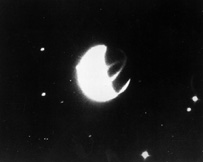Astrophysics From the Moon’s Advantages

Earth's Geocorona as Photographed From the
Moon |
Astronomy’s many great advantages from the Moon are well known within the scientific and space communities. In fact, lunar-based advantages are so numerous and all-encompassing that the idea that there is no astronomy being done from the Moon right now boggles the mind. The natural environment of the Moon is much friendlier to observatories than the Earth’s. No extensive human presence on the Moon also makes it more astronomically appealing. There are even several reasons that lunar-based astrophysics is superior to that which can be done with spaceborne telescopes and Mars, other moon or asteroid-based facilities. At the same time, difficulties for astrophysics from the Moon cannot be ignored.
The Moon’s near lack of atmosphere would eliminate much of the need for costly adaptive optics technology. Earth’s atmosphere also forces almost all (except radio) observatories to be placed at difficult to reach, high-altitude locations. Even then, the Sun, rain, clouds, air/wind and even the Moon hamper Earth-based observing. Storms and hurricanes can occur, sometimes damaging science facilities. Without the Earth’s elements, lunar telescopes can remain pristine longer; astronomical facilities on the Moon last forever. On Earth, daytime means no observations, but the Moon’s days (about fourteen Earth days) have a dark sky that allows for nonstop astronomy, which only requires use of a rotating baffle or sunshade. The Moon’s environment offers a platform proven to be more stable than the Earth’s. This enables the use of simple, low-cost telescope bases. Long exposure times, a characteristic shared by observations from both the Earth and the Moon, could allow for an effective Earth-Moon interferometer.
The Moon has no “light pollution” or other civilization-related viewing problems. Lunar observatories would not have to deal with nearly as much space debris, which can sometimes hinder viewing. The Moon also has relatively infinite room for astrophysics and astronomical facilities. An interferometer on the Moon could expand extensively due to the open lunar surface’s lack of ecosystem and cultural concerns such as those that involve the sacred summit of Mauna Kea on Hawai‘i Island. Radio observatories on the farside of the Moon would be free from RFI (radio frequency interference) – radio noise sent out by humans on the Earth.
Spaceborne telescopes can escape the Earth’s atmosphere, but with the added cost of expensive steering and aiming mechanisms. Also, space observatories’ dependence on expendable attitude control fuel severely limits their lifetimes, eventually leaving them to burn up in the Earth’s atmosphere, as will the Hubble Space Telescope. Without fuel-dependence and the wear and tear of constantly traveling at thousands of kilometers per hour through the atoms in the Earth’s outer atmosphere, lunar telescopes can live longer. Lunar-based telescopes can end up in museums someday, be preserved forever on the lunar surface or eventually be broken down and reused for parts or scraps. This allows them to contribute to human space activities and inspire the next generation of space enthusiasts better than space telescopes can. Once they are in need of maintenance, this can safely be done by in-situ ground repair, whereas servicing missions done in space are much more hazardous for astronaut technicians. Developing, implementing and controlling precise interferometers in space may someday become commonplace, but it is much more costly and complex than placing simple, inexpensive interferometers on the Moon that will produce just as much science. The Moon’s slow rotation around the Earth and great distance from it allow for longer exposure times than most spaceborne telescopes can achieve, so Moon-based observatories can provide more in-depth and revealing celestial observations.
Mars-based astronomy or astronomy from other moons or asteroids will surely come into its own someday. For now, lunar-based is superior due to its closer proximity (1.3 light-seconds) to the only human beings in the solar system. More convenient servicing, direct communication and easy emplacement are all factors that favor lunar-based, but the strongest is that we have landed on the Moon before. Humans have never landed on any other foreign body. Putting an operational observatory on the lunar surface after placing living human beings there over thirty-five years ago will not be too great of a challenge.
The lunar environment does, however, present several complications for astronomical facilities. Micrometeorites strike randomly though infrequently. Cosmic and solar radiation can slowly damage vital observatory instruments. Temperature shifts as large as 350 degrees Celsius and radiation could be hazardous to future human servicing missions. Also, lunar dust could pose problems for service missions as well as interfere with telescope operation.
Despite the difficulties, the ILO team is looking to the Moon in order to conduct humanity’s best astronomy. In utilizing the Moon’s environment, the ILO will open new frontiers, most notably the newest frontier for astronomy and astrophysics. Decades and perhaps centuries into the future, the ILO and other ILO missions could continue to inspire and benefit all of humanity. By then, similar to the Hubble, lunar-based astrophysics will have earned a place in the hearts of all astronomers, space enthusiasts and Earthlings alike.